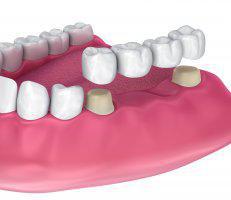What is a dental bridge?
A dental bridge is a type of oral prosthetic that literally “bridges the gap” between one or more missing teeth. Dental bridges contain a false tooth, or pontic, and attach to your permanent teeth on either side using an abutment crown.
Are there different types of dental bridges?
There are four main types of dental bridges.
Traditional dental bridge
Traditional dental bridges are ideal for people who have healthy, natural teeth on either side of a missing tooth. A traditional bridge features one false tooth and is bonded to your permanent teeth on either side with dental crowns.
Maryland dental bridge
Dr. Jue attaches a Maryland bridge to your natural teeth on either side of a gap. However, instead of using crowns to stay in place, a Maryland dental bridge uses a framework of metal or porcelain bonding.
Implant-supported bridge
Implant-supported bridges are just that: dental bridges supported by implants. These bridges typically require two procedures, but the results are worth it.
Cantilever bridge
Cantilever bridges are unique in that only one abutment tooth supports it. To receive a cantilever bridge, you only need one healthy tooth next to a gap.
What are the benefits of a dental bridge?
If you’re missing one or multiple teeth, your oral health is at risk. Investing in a dental bridge can:
- Restore your smile
- Improve your chewing ability
- Maintain your facial structure
Dental bridges can also improve your speech and pronunciation and prevent your other teeth from moving out of place.
How is a dental bridge applied?
Getting a dental bridge requires two separate appointments.
At your first appointment, Dr. Jue performs a thorough oral exam and takes impressions of your teeth. Depending on the condition of your teeth, he uses this information to manufacture a same-day bridge or sends the data to a dental laboratory. After taking impressions, Dr. Jue administers a local anesthetic and prepares your surrounding teeth for the dental bridge.
At your second appointment, Dr. Jue once again administers a local anesthetic and places your dental bridge, permanently bonding it to your teeth. The bridge may feel awkward at first, but you’ll adjust over time. If you experience any pain or discomfort, let Dr. Jue know and he can make necessary adjustments.
To learn more about how dental bridges can restore your smile, call or use the online booking tool and make an appointment today.

